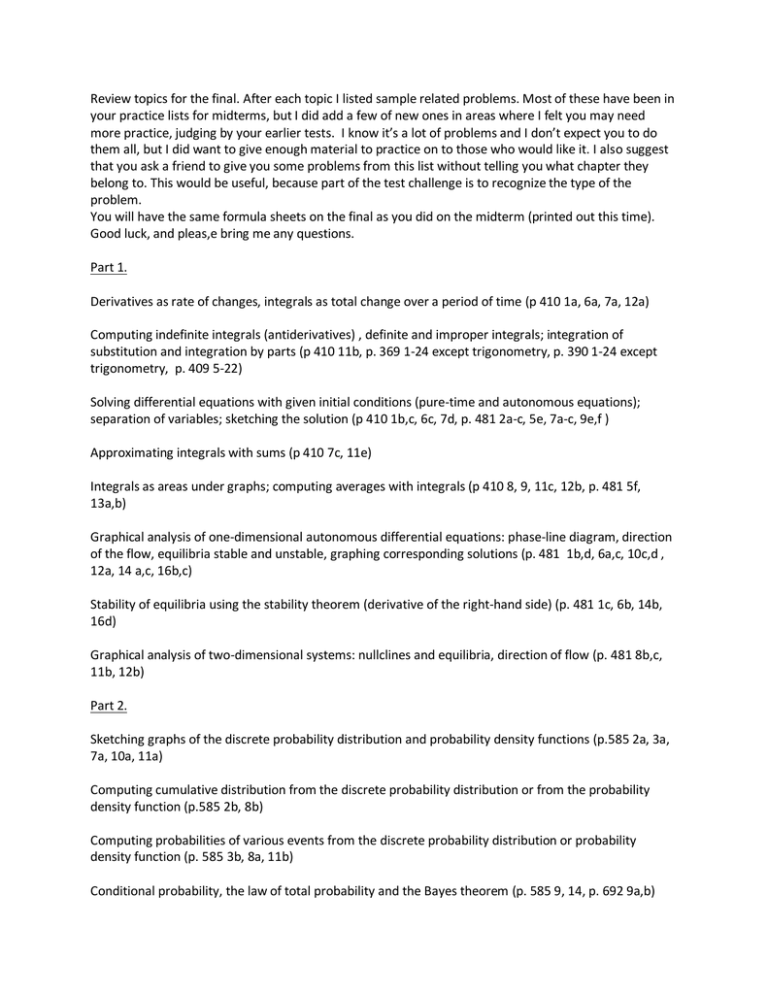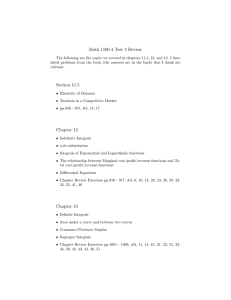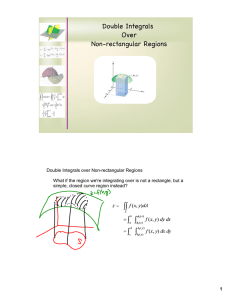Document 12123345
advertisement

Review topics for the final. After each topic I listed sample related problems. Most of these have been in your practice lists for midterms, but I did add a few of new ones in areas where I felt you may need more practice, judging by your earlier tests. I know it’s a lot of problems and I don’t expect you to do them all, but I did want to give enough material to practice on to those who would like it. I also suggest that you ask a friend to give you some problems from this list without telling you what chapter they belong to. This would be useful, because part of the test challenge is to recognize the type of the problem. You will have the same formula sheets on the final as you did on the midterm (printed out this time). Good luck, and pleas,e bring me any questions. Part 1. Derivatives as rate of changes, integrals as total change over a period of time (p 410 1a, 6a, 7a, 12a) Computing indefinite integrals (antiderivatives) , definite and improper integrals; integration of substitution and integration by parts (p 410 11b, p. 369 1-24 except trigonometry, p. 390 1-24 except trigonometry, p. 409 5-22) Solving differential equations with given initial conditions (pure-time and autonomous equations); separation of variables; sketching the solution (p 410 1b,c, 6c, 7d, p. 481 2a-c, 5e, 7a-c, 9e,f ) Approximating integrals with sums (p 410 7c, 11e) Integrals as areas under graphs; computing averages with integrals (p 410 8, 9, 11c, 12b, p. 481 5f, 13a,b) Graphical analysis of one-dimensional autonomous differential equations: phase-line diagram, direction of the flow, equilibria stable and unstable, graphing corresponding solutions (p. 481 1b,d, 6a,c, 10c,d , 12a, 14 a,c, 16b,c) Stability of equilibria using the stability theorem (derivative of the right-hand side) (p. 481 1c, 6b, 14b, 16d) Graphical analysis of two-dimensional systems: nullclines and equilibria, direction of flow (p. 481 8b,c, 11b, 12b) Part 2. Sketching graphs of the discrete probability distribution and probability density functions (p.585 2a, 3a, 7a, 10a, 11a) Computing cumulative distribution from the discrete probability distribution or from the probability density function (p.585 2b, 8b) Computing probabilities of various events from the discrete probability distribution or probability density function (p. 585 3b, 8a, 11b) Conditional probability, the law of total probability and the Bayes theorem (p. 585 9, 14, p. 692 9a,b) 2-state Markov processes: diagram of the process, deriving a discrete-time dynamical system for the probabilities, finding long-term probabilities (p. 585 4, 13a-c, 15) Finding expected value, variance and standard deviation for discrete and continuous random variables (p. 585 2c, 7b, 10b, p. 692 7a Finding probability, expected value, variance, standard deviation from known distributions: Binomial geometric Poisson exponential (Binomial and Poisson are counting the NUMBER of events, geometric and exponential are about TIME between events) (p. 692 1 a,c,d, 3a-c, 5a-c, 6, 11, 12, 13, 14a, 16a-c) Central limit theorem for sum and average of random variables (p. 690 35-37, 30, 31, p. 679 1-4) Normal computations – finding probabilities for given normal distributions (p. 692 15a, p. 690 5-14) Joint distribution from conditional probabilities (p. 692 2a-c, 4d, 8a,b, 9c ) Finding correlation and covariance from joint distribution (p. 692 2e, 8c, 18c) Likelihood function, maximum likelihood estimators (p. 705 9-12, 15-18, 21, 22) Confidence interval for proportion (exact computation (p. 717 7, 8, 31, 32), method of support (p. 717 11, 12, 34) normal approximation (p. 798 9a, p. 732 29, 30))






